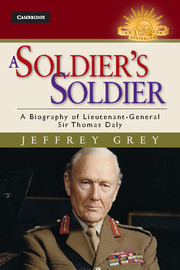Book contents
- Frontmatter
- Contents
- Illustrations
- Maps
- Tables and diagrams
- Acknowledgements
- Abbreviations
- Chapter 1 Regimental soldiering
- Chapter 2 Balikpapan, 1945
- Chapter 3 ‘He could fill any appointment with distinction’
- Chapter 4 The challenges of senior rank
- Chapter 5 Chief of the General Staff
- Chapter 6 Daly, the army and the war in Vietnam, 1966–71
- Chapter 7 The civic action crisis, 1971
- Chapter 8 Epilogue
- Notes
- Sources and Bibliography
- Index
Chapter 4 - The challenges of senior rank
Published online by Cambridge University Press: 05 February 2014
- Frontmatter
- Contents
- Illustrations
- Maps
- Tables and diagrams
- Acknowledgements
- Abbreviations
- Chapter 1 Regimental soldiering
- Chapter 2 Balikpapan, 1945
- Chapter 3 ‘He could fill any appointment with distinction’
- Chapter 4 The challenges of senior rank
- Chapter 5 Chief of the General Staff
- Chapter 6 Daly, the army and the war in Vietnam, 1966–71
- Chapter 7 The civic action crisis, 1971
- Chapter 8 Epilogue
- Notes
- Sources and Bibliography
- Index
Summary
The remaining years of Daly's army career, from his promotion to major-general in August 1957 until his retirement as Chief of the General Staff in 1971, were turbulent ones for the institution of which he was a part and to which he had devoted his adult life. There were major reorganisations in 1957 and, more radically, in 1959. The commitment to the Far East Strategic Reserve in Malaya that began in 1955 was relatively modest but so, too, was the army that maintained it. The mid-1960s saw another reorganisation – more correctly, perhaps, a reversion to an earlier model, but disruptive for all that – and the beginning of the deployment of increasingly larger forces to the war in Vietnam, which would be the main item on his agenda for every one of his years as the professional head of the service.
Daly's new posting was as GOC of Northern Command, based in Queensland but with responsibility as well for the 8th Military District, which encompassed the Territory of Papua and New Guinea (TPNG). The regional command structure was as old as the Commonwealth itself, although it had undergone a variety of name changes and partial or wholesale restructuring at various points during the previous half-century. In common with other, long-standing features of the army as an institution the origins of the system lay in the colonial structures that the army and the Commonwealth had inherited in 1901. Originally named ‘military districts’ with a numerical designator (Northern Command was the 1st Military District or 1MD), they were given territorial labels as part of the reforms recommended by the Inspector-General, Lieutenant-General E.K. Squires, just before the outbreak of the Second World War. The crisis of 1942 prompted a clean sweep of the army's higher organisation and command structures under the direction of the second wartime CGS, Lieutenant-General Vernon Sturdee, geared to the defence of Australia and the prosecution of the offensive against the Japanese in the islands to Australia's north. Sturdee, Blamey's immediate postwar successor as Commander-in-Chief of the Australian Military Forces (AMF) and subsequently the first postwar CGS, reverted essentially to the model that Squires had recommended in 1939, reconstituting the Military Board along established lines as well.
- Type
- Chapter
- Information
- A Soldier's SoldierA Biography of Lieutenant General Sir Thomas Daly, pp. 90 - 113Publisher: Cambridge University PressPrint publication year: 2012



